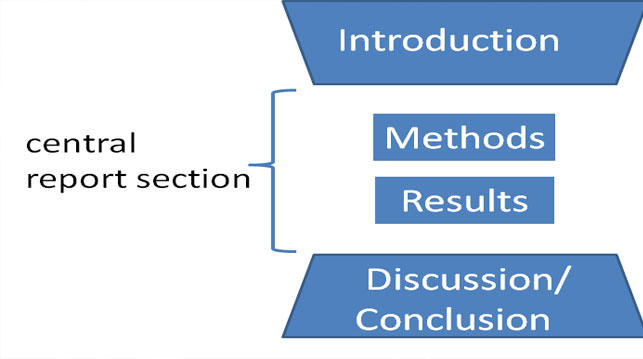
Lately, we’ve been talking a lot about formatting, how to structure your references in a paper so that they adhere to the style guidelines of a certain field or publication. From APA to IEEE, MLA to Vancouver, many different formatting styles exist to help readers follow along with your research and delve into your sources.
But what about the structure and formatting of the paper itself? That’s another key feature of writing that helps readers follow along with you on your research journey.
Many of us learned basic writing structure in high school; the five-paragraph essay is hammered home in many an English class. In that format, you have an introduction, three supporting points (typically at one paragraph each), and a conclusion. Although this is a really handy framework that can be expanded and applied to many writing projects throughout life, it’s not quite sufficient for much academic writing.
Fortunately, there’s another framework that will do the trick: IMRaD.
Get a free sample proofread and edit for your academic document.
Two professional proofreaders will proofread and edit your academic document.
What Is IMRaD Format?
IMRaD is a handy-dandy way to remember the names and orders of the major sections of most academic manuscripts. Those sections are:
• Introduction
• Materials and Methods
• Results
• Discussion and Conclusions

You’ll also want to include the title and abstract when submitting your finished manuscript, but those come at the end. When developing your paper in the first place, these are the main sections you’ll want to be thinking about.
Each section will vary in length depending on your work and what you need to include, but each should make an appearance in your paper. You may also want to add sections such as a literature review; again, the specifics depend on your research and your field.
Introduction
Here, you explain what you plan to discuss, why your research is necessary or how it contributes to the literature, the main hypothesis or hypotheses you will tackle, and how the rest of the paper will be structured.
This is also a good place to include a literature review sub-section to show what other work has been done in your area and how you plan to build on it.
Think of your introduction as a road map: this is where you outline the need for getting to your destination, as well as a plan for how you’ll get there, noting a few major stops along the way.
Materials and Methods
This section outlines how you did your research. Was it quantitative or qualitative? What research approach did you use? What theoretical lens or framework? How did you select your sample? How did you set up your experiments?
This is actually one of the first sections you should tackle when writing up your research, as it’s one of the most straightforward. In it, you simply report what you did to structure and perform your work. If you kept good notes during your research phase, this should be pretty easy.
Results
Once again, you’re simply reporting what you uncovered during the course of your research. Don’t get into interpreting the results here—that’s what the Discussion section is for.
Instead, all you need to do here is report what you found. Give the bare facts of your research, like the descriptive statistics on your sample or the results of a multinomial regression analysis. What did you find when you executed the research plan you describe in materials and Methods? Lay out all that information here.
Discussion and Conclusions
This is the fun part for most researchers. You get to talk about what your results actually mean.
These two areas are slightly different and might take shape as two different sections, or you might choose to combine them. It all depends on the journal to which you’re submitting and your personal preference, as well as how your research is structured.
The discussion involves commenting on the results you obtained and related in the previous section. You’ve already reported the data and the straightforward facts of what you found during your research. But how does this relate to the phenomenon you were investigating? Does it support or contradict other studies on the same topic? Call back to your literature review and tie your results to previous work to show how you’ve contributed to the body of knowledge for your field.
You might also suggest additional research that could build on what you’ve found, or new areas to explore that will expand the applications or usefulness of your current work.
In the conclusion section, you get to expand beyond what your results mean and how they relate to earlier work and draw bigger conclusions. How can your results be applied in practice? Can you generalize them to a broader population? Is there a larger context in which your results are meaningful or useful? How can the world at large benefit from learning about what you’ve discovered, or applying it in some way?
Tips for Structuring an Academic Paper
When structuring your paper, remember to prioritize logical flow. You want your reader to be able to go from idea to idea smoothly, with good transitions between topics and arguments.
Guide the reader from the background that led you to start the research to the ways you set up your experiments or research plan. Describe all aspects of your plan and execution, then report the results. Finally, discuss what the results mean in context and then extrapolate to broader conclusions or practical applications.
Above all, be clear, be consistent, and keep your audience in mind. The best academic articles have plenty of sub-headings for easy navigation and use approachable, clear language instead of hard-to-decipher jargon or convoluted phrasings. A good editor can help you polish up your writing and get it ready for publication.
With IMRaD at your disposal, you’re ready to structure your paper for success.
Happy researching and writing!
Kate S.
Get a free sample proofread and edit for your academic document.
Two professional proofreaders will proofread and edit your academic document.
Get a free sample proofread and edit for your document.
Two professional proofreaders will proofread and edit your document.
We will get your free sample back in three to six hours!